Table of Contents
- Lead Generation Statistics 2023
- General Lead Generation Statistics
- Market Value
- Regional Value
- Lead Generation Statistics – Through Social Media
- Lead Generation Through Email Marketing
- Lead Generation Statistics – Various Marketing Channels
- Lead Generation – Challenges in Lead Generation
- Lead Generation – by Software
- Recent Developments
- Conclusion
- FAQ’s
Lead Generation Statistics: Lead generation involves identifying and attracting “leads”, or potential customers, for the company’s services or products.
This process involves using several sales and marketing techniques to attract an individual and convert them into a customer.
Lead generation is creating a pool of individuals who are interested in your product and will likely become customers. With targeted marketing, leads can be nurtured and turned into paying customers.
Lead generation can occur through both digital and conventional methods. These include social media marketing (including email marketing), SEO, content, webinars and other events, direct marketing, and much more.
Lead generation can be measured by various metrics including the number of leads, revenue generated, and conversion rate.
Creating leads is undeniably difficult if you don’t have a focused lead-generation strategy tailored to your industry.
Taking on challenges and converting leads to sales can be relatively simple if you understand your target audience and their needs. Let’s look at some general lead generation statistics to help you understand the market.
Lead Generation Statistics 2023
- The Global Customer Relationship Management (CRM) Software Market size is expected to be worth around USD 248.2 Billion by 2033, from USD 75.1 Billion in 2023, growing at a CAGR of 12.7% during the forecast period from 2024 to 2033.
- Lead generation is the top priority for 50% of marketers in their marketing campaigns.
- On average, organizations generate 1,877 leads.
- The average cost per lead generated in the industry is $198.44.
- 97% of people avoid cold business calls.
- Content marketing is used by 76% of advertisers to generate leads.
- According to 68% of marketers, digital markets have assisted them in generating more leads than other sources.
- According to 61% of marketers, the most difficult challenge is lead generation and conversion.
- 80% of marketers believe that market automation aids in large-scale sales generation and conversion.
- Just six hours a day are spent on social media by 66% of marketers to generate leads from social media.
- 53% of marketers spend more than 50% of their budget on lead generation for their business.
- Companies that publish more than 15 blogs per month generate an average of 1200 potential clients per month.
- 43% of online shoppers open branded emails at least once per day.
- Social media marketing is a great way to generate leads for 66% of marketers. They spend 6 hours a week on it.
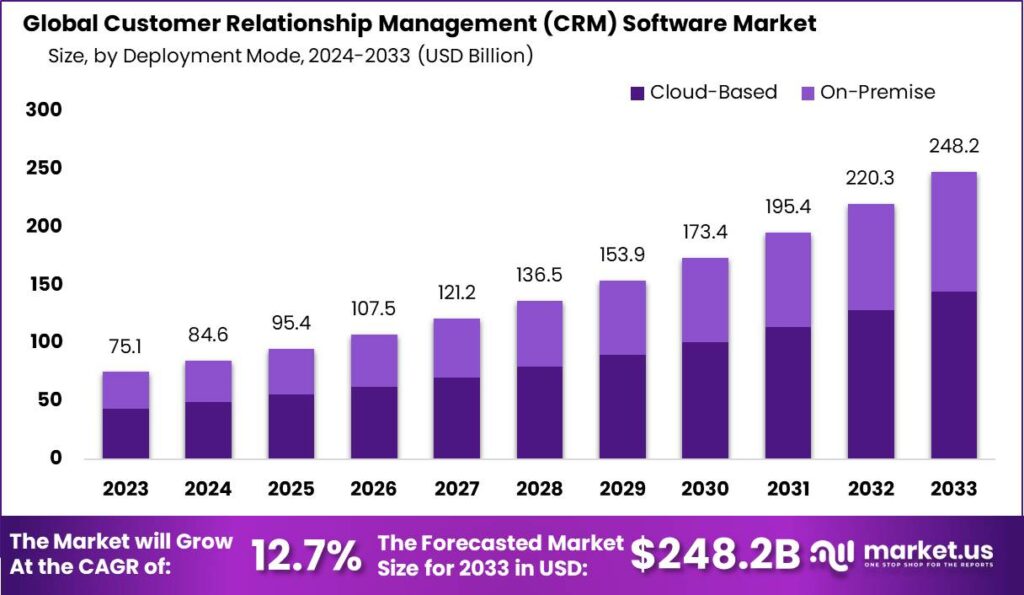
General Lead Generation Statistics
- Lead generation is the number one challenge for 61% of marketers.
- 53% of marketers use at least half of their total budget on lead generation.
- Only about one-fifth of marketers believe that outbound practices help generate valuable leads.
- Automation, reported by 80% of marketers, generates a greater number of conversions and leads.
- According to reports, the majority of mid-size businesses generate fewer than 5,000 qualified leads per month.
- Lead generation is the most important marketing goal for 85% of B2B companies.
- 58% of marketers expected to increase their lead generation budget in the coming years.
- Only 18% of marketers believe that outbound leads help them gain valuable leads.
- 78% of companies use email marketing strategy to generate leads, 73% use event marketing, and 67% use content marketing to generate leads.
- It has been reported that using market automation software increases lead generation by 451%.
- 68% of B2B companies are struggling to generate leads.
- Form submission is used by 84% of marketers to generate leads.
- 33% of businesses said they use live chat to generate leads.
- The average cost per lead generated across all industries is $198.44.
- According to the organizations, four out of every five leads are marketing-qualified leads.
- According to 34% of marketers, the top priority for the goals they want to achieve in the coming year is lead generation.
- Access to more accurate data, according to 39.5% of marketers, could improve the lead-generation process.
- 21.36.6% of marketers believe that increasing team size will help them generate more leads and market more effectively.
- 22.35.1% of marketers believe that increasing the budget will result in better marketing and more leads.
- 97% of people avoid cold business calls.
(Sources: Content Marketing Institute, Hubspot, Business Wire)
Market Value
The global market for lead generation will reach USD 6,38 billion in 2025. The market is growing at a rate of 8.3% per year.
According to the report, factors like increased digital advertising adoption and rising consumer intelligence demand are major industry drivers.
Lead generation has grown due to the popularity of social media and the desire of businesses to engage and connect with their audiences.
Market expansion will also be driven by content marketing, email marketing, and marketing automation.
Regional Value
- The Continent of North America the North American Lead Generation Market is expected to grow at a 7.8% CAGR through 2025. This expansion can be attributed to the use of digital marketing techniques as well as the presence of key market players.
- Europe The European Lead Generation Market is expected to grow at a 9.5% CAGR between 2019 and 2025. This expansion can be attributed to the greater use of content marketing and social media strategies.
- The Asia Pacific Lead Generation Market is expected to grow at an 11.1% CAGR between 2019 and 2025. Increased digital marketing technologies, smartphone adoption, and growth in the e-commerce industry can all be attributed to the increase in growth.
- World at Large The rest of the world’s lead generation market is projected to expand at a 7.4% compound annual growth by 2025. This expansion can be attributed to emerging economies’ increased use of digital marketing.
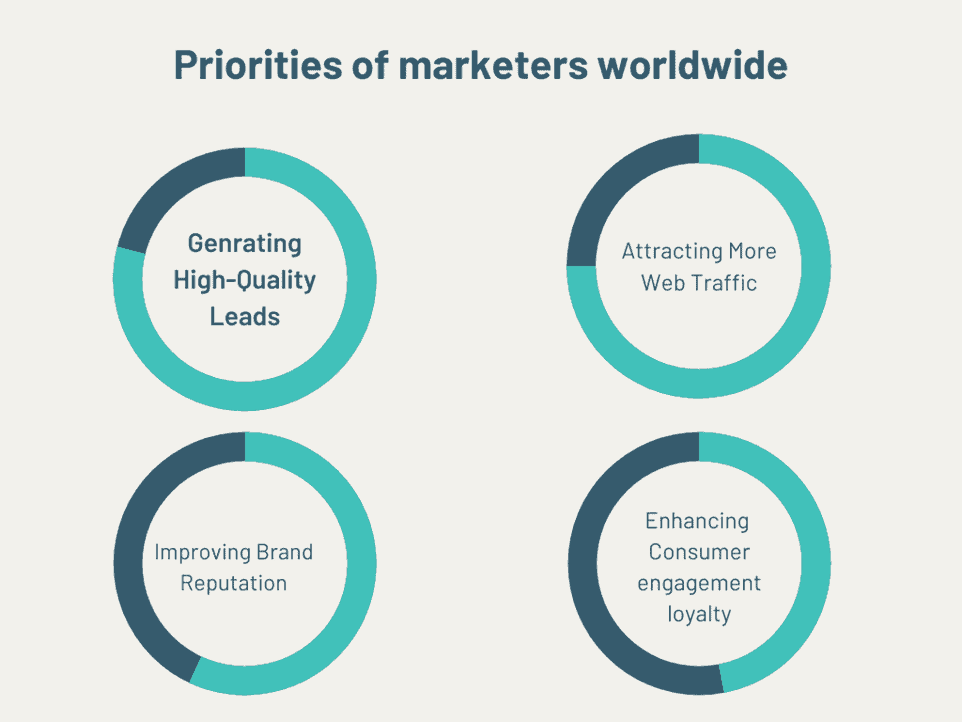
Lead Generation Statistics – Through Social Media
Social media has enormous potential for generating leads and converting them into paying customers. Before purchasing products from you, most potential customers will look through all of your social media accounts and check out your handles. Let’s look at how social media affects businesses’ lead-generation processes.
- 66% of marketers are successful in generating leads after spending only 6 hours per week on social media marketing.
- Social media can generate strong leads, according to 19% of marketers.
- According to reports, LinkedIn is the most effective social media platform for generating B2B leads.
- LinkedIn was successful in generating customers for 45% of marketers.
- 47% of marketers expressed an interest in learning more about TikTok.
- 74% of internet users claimed they prefer to see 1 to 2 posts per day from brands they like and follow.
- 51% of consumers prefer brand posts that highlight the brand’s products.
(Sources: Digital media stream, Semrush, Social media examiner)
Email is the most used communication channel for lead generation
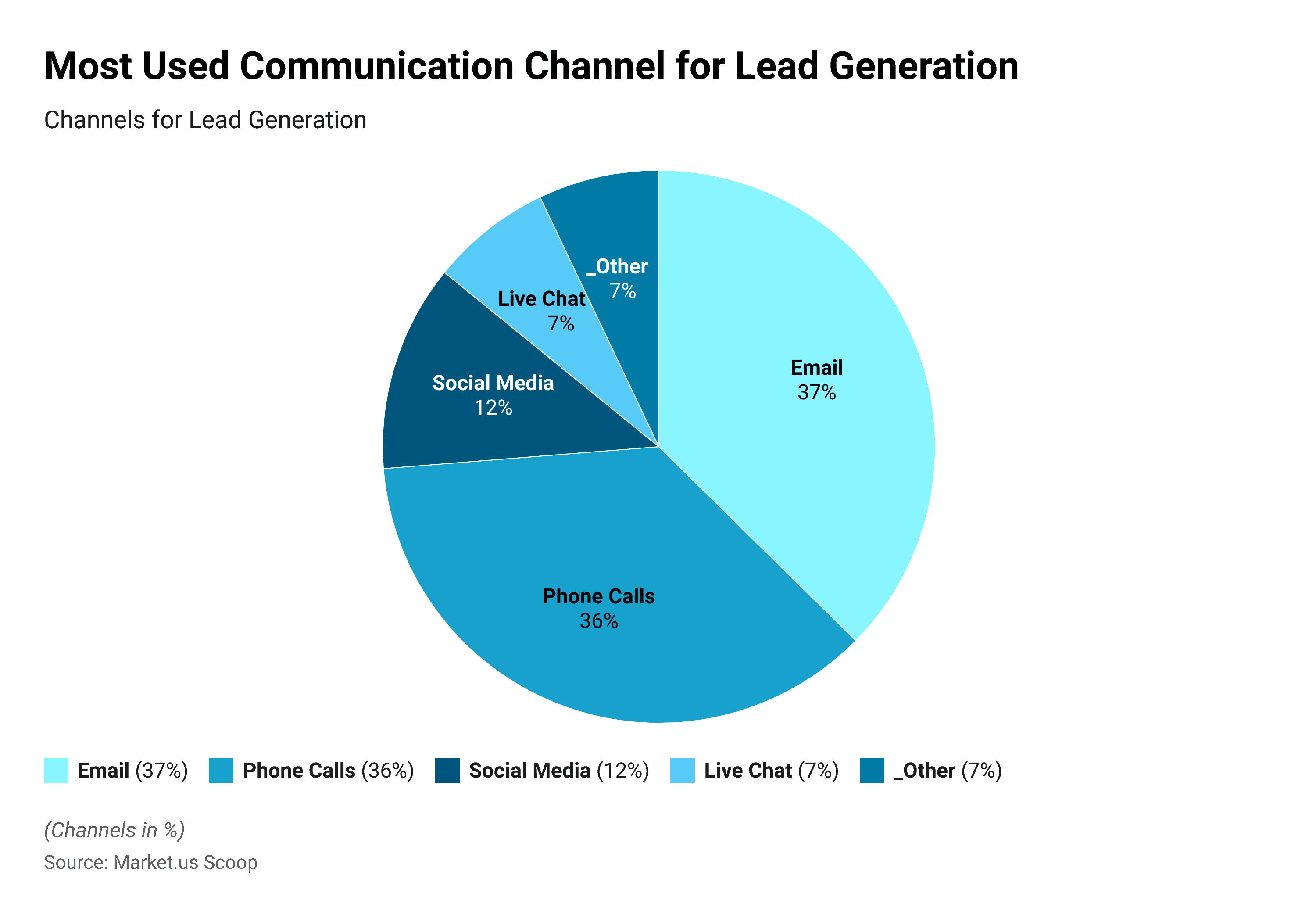
According to a Convince & Convert survey, the most popular communication channels for following up on leads are email (37%) and phone calls (36%). Only 6% of those polled prefer SMS communication for follow-up, while 7% prefer live chats.
Lead Generation Through Content Marketing
Content marketing is the fastest-growing marketing strategy. Without a doubt, most businesses use content marketing to generate new leads and convert them into customers. Here are a few statistics about content marketing and lead generation that you should be aware of.
- Content marketing generates three times more leads than outbound marketing at a fraction of the cost.
- Content media costs 62% less than traditional marketing.
- Over the next 12 months, 80% of B2B companies will use content marketing to generate leads.
- It was discovered that marketers who had blogs were 13 times more likely to generate a higher rate of leads.
- An effective blog generates 500% more traffic.
- 78% of businesses use website traffic to assess the effectiveness of their content.
- 75% of businesses can demonstrate the impact of content marketing and the number of people who are engaged as a result of it.
- B2B companies who write blogs make 67% more prospective clients than companies that do not blog.
- Companies that publish 15 or more blogs per month generate an average of 1200 new leads per month.
- Marketers who use blogging and content marketing typically generate 13 times more positive ROIs.
- According to 77% of marketers, podcasts are the most effective content for generating leads.
Here is the graph about the medium of content that is most effective in lead generation:
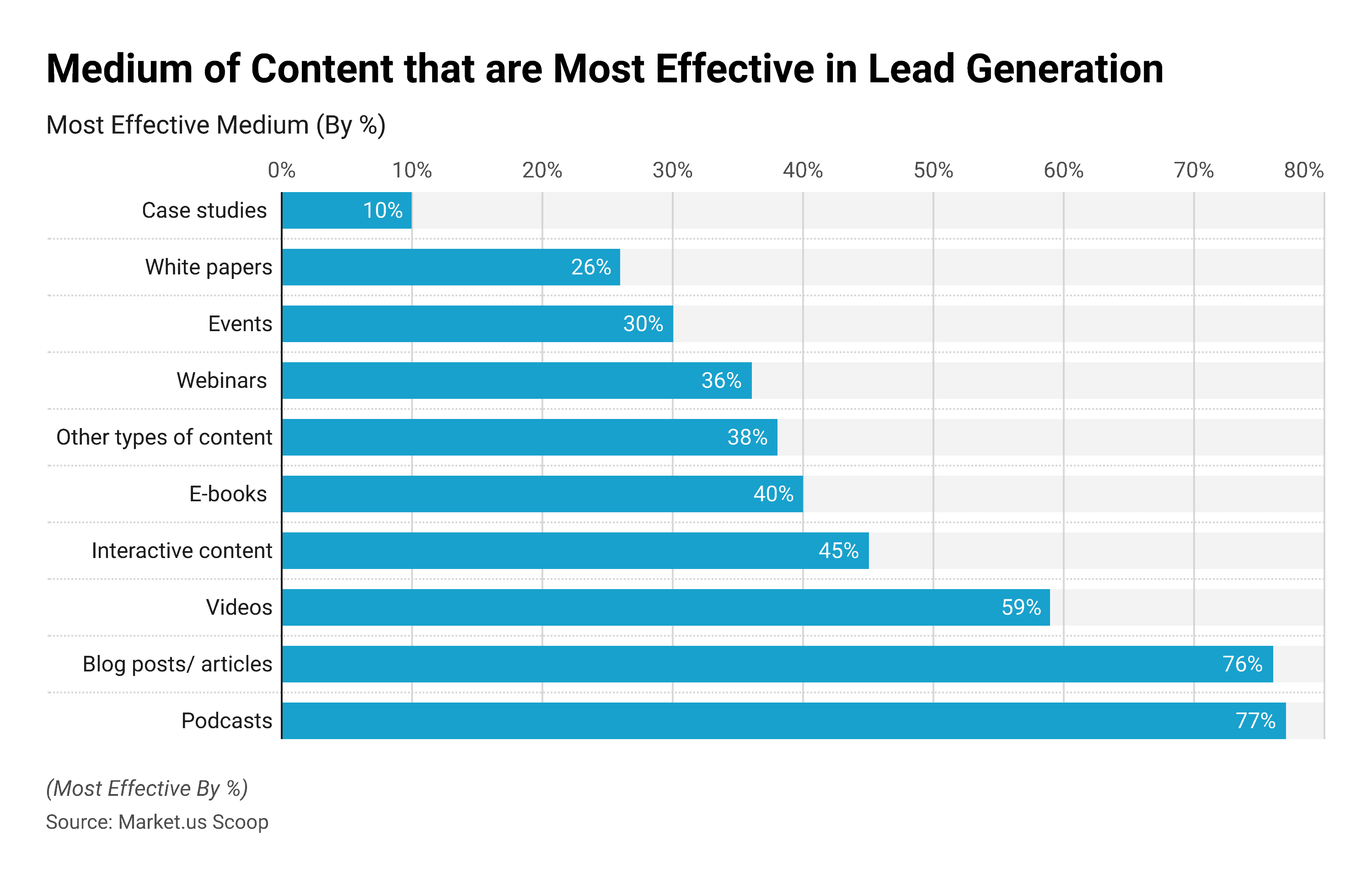
(Source: Wired, Hubspot, Content Marketing Institute)
Lead Generation Through Email Marketing
Email marketing is one of the most popular lead-generation strategies, with a high rate of success. Most B2B business owners believe that email marketing is the most dependable source for generating leads and converting them into sales.
Email marketing can also help a business attract organic traffic. Let’s look at some email marketing and lead generation statistics.
- 42% of businesses consider email to be one of the most important lead generation factors.
- According to 79% of B2B marketers, email marketing makes demand generation easier.
- Email marketing generates higher ROIs than other lead-generation tools and channels.
- It has been reported that for every dollar spent, you will receive 44 dollars in return.
- Emails sent at 1 p.m. were reported to produce the best results. Other times that were found to be suitable for sending emails were 8 a.m., 4 p.m., and 6 p.m.
- Email is regarded as the most effective demand-generation tool by 80% of marketers.
- According to 56% of marketers, providing leads with compelling content at each stage is the key to B2B email success.
- According to 49% of marketers, providing downloadable content at each stage of the purchasing process is beneficial for converting leads.
- 45% of businesses think behavior-based email advertising campaigns are more effective.
- Marketing emails have an overall open rate of 21.5%.
- Mondays have the highest email open rates (22%) of any day. On Tuesday and Wednesday, the click-to-open rate was 10.8%.
- Approximately 43% of online shoppers open branded emails at least once per day.
- 60% of consumers said they bought at least one monthly product after reading the brand’s email.
(Source: Hubspot, Digital Commerce 360)
Lead Generation Statistics – Various Marketing Channels
Leads are generated in the market through various channels. Using various web channels, many new audiences are converted into leads.
Let’s take a look at all of the channels that contribute to the lead generation process.
- 95% of marketers predicted that they knew which channel generated the majority of the leads needed for their business.
- Organic search, according to 27% of marketers, assists in the generation of more leads.
- 21% of businesses said they got the majority of their leads from organic social media searches.
- According to 14% of marketers, referrals are the best way to generate leads.
- Paid search, according to 1% of marketers, was the most effective in generating maximum leads.
(Source: Semrush, Hubspot)
B2B Lead Generation
When compared to B2C customers, B2B businesses typically find it more difficult to generate leads and convert them into sales.
These businesses’ lead generation requires more effort and strategies to find strong leads and convert them into customers. Here are a few key statistics about B2B companies.
- Sixty-eight percent of B2B marketers used strategic landing pages for leads.
- It was reported that the events were most effective at generating B2B market leads.
- The average cost of generating a B2B sales lead ranged from $31 to $60.
- According to 59% of B2B marketers, SEO has the greatest impact on lead generation.
(Source: Hubspot, Business Wire, Semrush)
Lead Conversion
Once the leads have been nurtured and cared for, the next step is to convert them into customers. One of the most difficult aspects of the process is lead conversion, which necessitates patience and hard work.
Let’s take a look at some key lead conversion statistics.
- According to reports, 63% of leads who inquired about the company would not be interested in converting into customers for at least three months.
- 70% of B2B marketers believe that video content helps convert leads.
- You will fail to convert 79% of leads into sales.
- Professional services are converted into 9.3% of leads.
Here is the graph about the conversion rates observed in different industries:
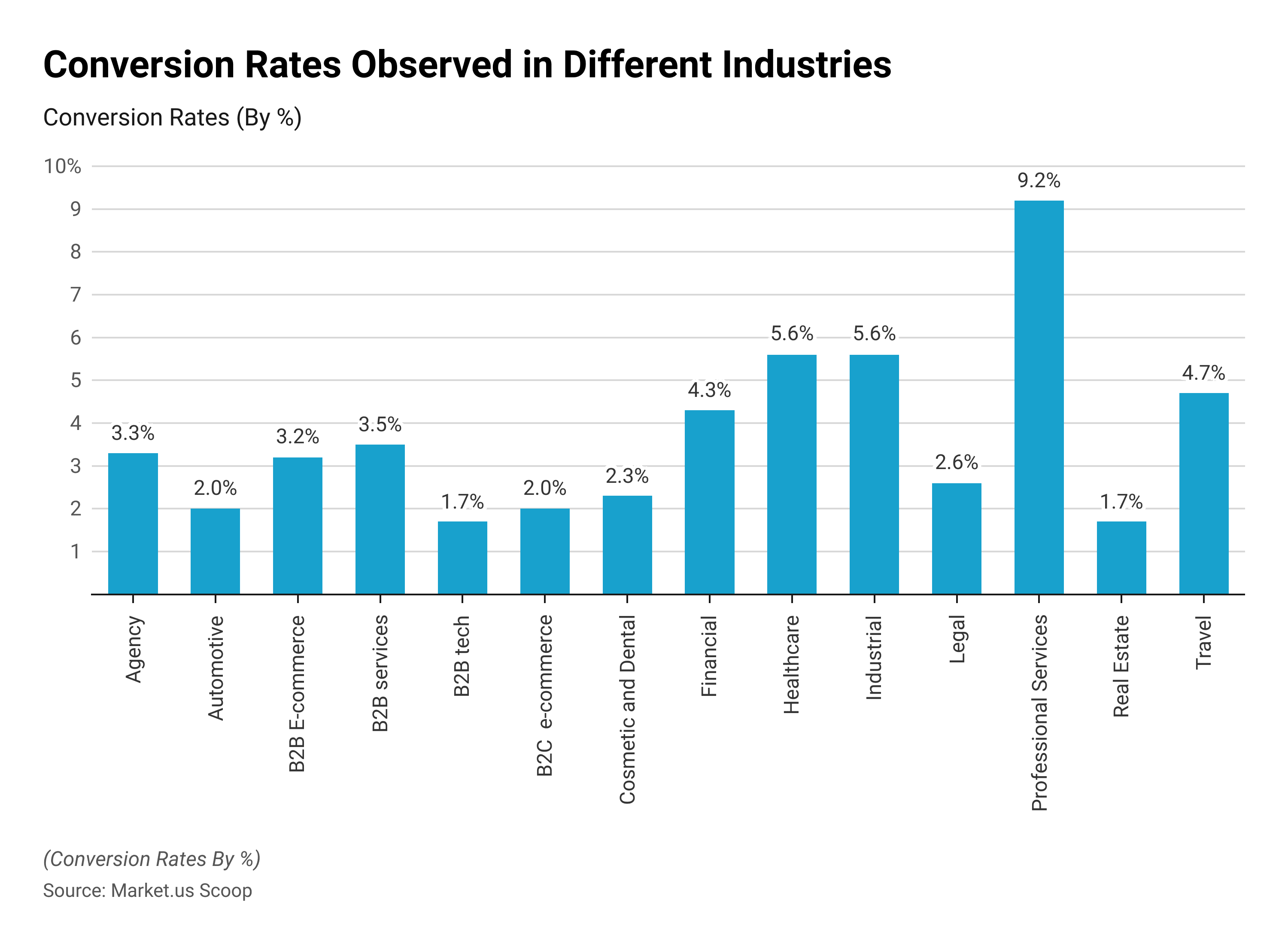
(Source: Digital Commerce 360, Digital media stream)
Lead Nurturing
Following the successful generation of leads, the next step is to nurture them. Nurturing leads necessitates receiving regular updates from them and informing them about new products.
You must maintain contact with the leads you have generated and pique their interest in your company to convert them into sales or customers.
- Nurtured leads result in a 20% increase in sales.
- It was discovered that companies that nurtured leads were able to generate 50% more sales while spending 33% less money.
- When compared to non-nurtured leads, nurtured leads make 47% more large purchases.
- Almost two-thirds of the leads are not sales-ready.
- Lead nurturing email marketing has 8% higher CTRs and 4 to 10 times higher response rates.
- 22% of B2B companies nurture their leads every week.
- 41% of businesses reported having difficulty following up with leads quickly.
- 44% of sales representatives are typically too busy to follow up on leads.
- 44% of sales representatives complain about the sales team’s poor handling of leads.
(Source: Verse, Digital media stream)
Lead Generation – Challenges in Lead Generation
Lead conversion can be difficult at times. The most difficult challenge for the company is engaging the audience and generating leads. Let us look at some of the challenges that businesses face during the lead generation process.
- According to 40% of marketers, the biggest barrier to lead generation is a lack of resources, improper budgeting, and insufficient staff.
- Approximately one-quarter of marketers struggle to calculate lead conversion rates.
- According to 61% of marketers, the most difficult challenge is generating high-quality leads that are more likely to convert into customers or generate sales.
- 68% of B2B companies are unable to correctly identify their funnel.
- A proper lead nurturing process is missing in 65% of B2B businesses.
- 31% of marketers thought tracking offline conversions was difficult.
- According to 31% of marketers, one of the most difficult challenges they face when generating leads is proving ROI.
(Source: Hubspot, Digital media stream, Semrush)
Trends in Lead Generation (2023 & Beyond)
- In-person pitches are becoming obsolete. To stay afloat, having a strong, competitive online presence is more important than ever. Here are some pointers to keep in mind when pursuing B2B and B2C prospects in 2023.
- Users “land” on the landing page after pressing on an advertisement or a link online. A lead-generating site directs customers to a page that encourages them to subscribe, buy, or sign up. If you even include a simple form on your landing page, you will generate significantly more leads. Make sure you have it in place as soon as possible!
- Featured Snippets: The highlighted snippets are short texts that look at the top of Google’s search results to quickly respond to an inquiry. The information inside of a Featuring Snippet is retrieved automatically from web pages in Google’s index. You can optimize your content for featured snippets and hope for an increase in organic traffic when people search.
More Lead Generation Trends:
- Community-based marketing.
- Hyper-personalisation
- Google Advertising
Lead Generation – by Software
- Marketing technology has evolved into a necessary business tool. According to the leading generation applications statistics based on an IDC report, 45% of enterprises globally will use emerging technology such as AI and big data for marketing activities throughout 2022 and beyond.
- Furthermore, according to lead generation statistics for 2022, CMOs and individuals are more willing to invest in technology for marketing automation that may assist with streamlining lead generation-related tasks such as creating content.
- According to IDC, by 2023, 45% of Global 2000 business-to-business (B2B) and business-to-enterprises will use personalization for context-based engagement, as well as AI, big data, and conversational computing.
- To supplement their lead generation efforts, 88% of marketers intend to use web analytics tools. 2021.
- According to Marketing Charts, 79% of marketing professionals use automation in email marketing (2021).
- The majority of marketers who use automation do so for triggered emails (82%), drip or nurture campaigns (67%), segmentation (56%), and A/B testing (45%), according to Marketing Charts (2021).
- According to the Martech Alliance, 33% of marketing teams use no-code/low-code tools regularly.
- 52% of businesses have complete CRM and marketing software integration.
- 20% of CMOs and marketing leaders will invest significantly in their marketing organization’s content marketing platform.
(Source: IDC, 2021, Welcome, 2020, Salesforce, n.d.)
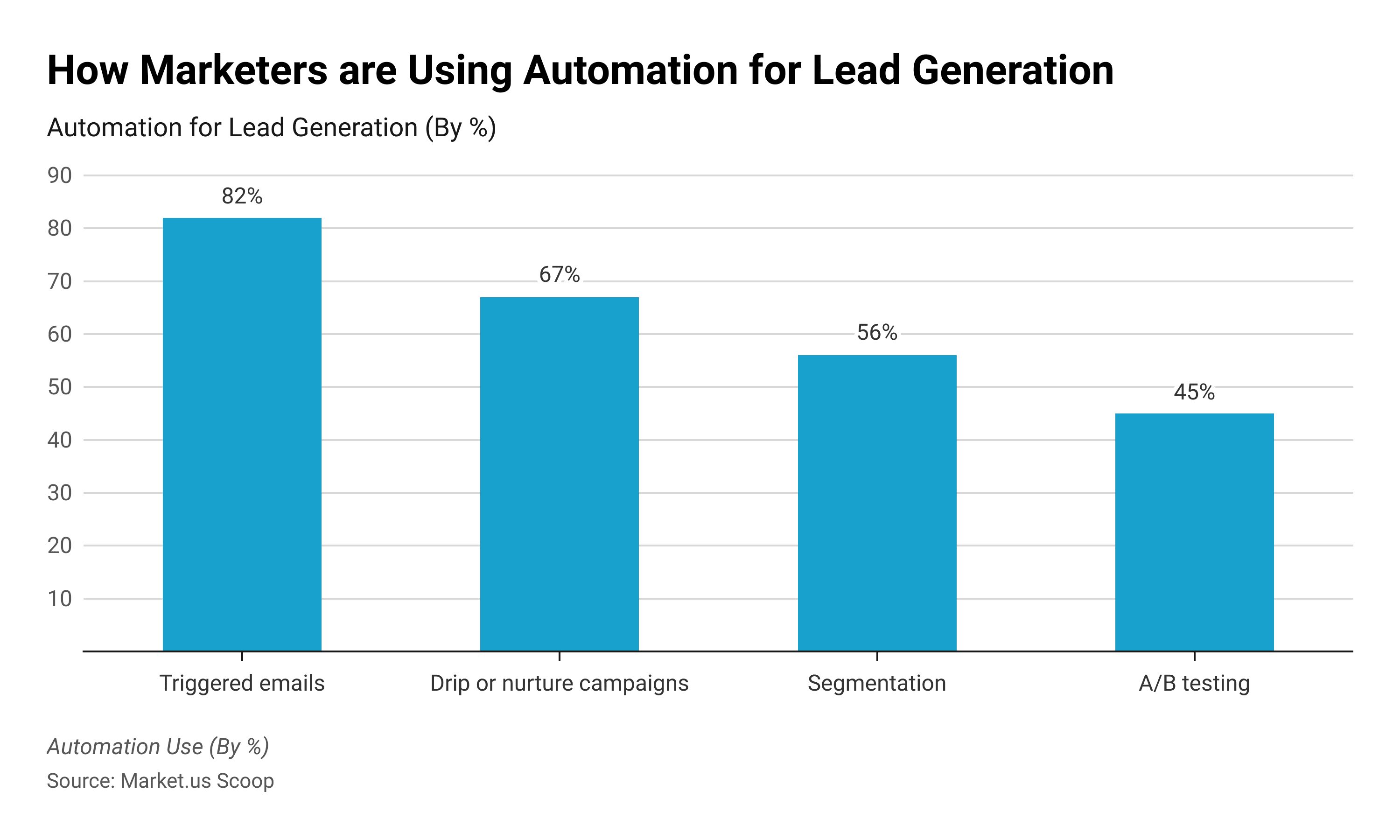
(Source: Marketing Charts, 2021)
Recent Developments
Mergers and Acquisitions:
- In the lead generation industry, notable acquisitions include Blackstone Real Estate Partners acquiring Tricon Residential Inc. on May 1, 2024.
- Additional significant deals include Chevron Corp’s acquisition of Hess Corp for $53 billion in October 2023, and Exxon Mobil Corporation’s merger with Pioneer Natural Resources valued at $59.5 billion in the same month, showcasing substantial investments and consolidations within the sector.
Compliance Requirements:
- Lead generation companies must adhere strictly to data security laws due to their role in handling sensitive consumer information. This includes compliance with federal and state privacy laws, such as the California Consumer Privacy Act, and ensuring that data is protected through industry-standard encryption and disposal processes.
- HIPAA compliance is critical for those in the healthcare space, necessitating robust programs to handle protected health information and personally identifiable information.
- Companies must also navigate telemarketing and SPAM laws, ensuring that all marketing communications comply with the Telephone Consumer Protection Act and CAN-SPAM Act to avoid hefty penalties.
- Additionally, the diligence process during acquisitions in this field requires a rigorous examination of the target’s compliance with applicable industry-specific laws, whether those pertain to consumer lending, debt collection, or other regulated sectors.
Conclusion
Lead Generation Statistics – Lead generation is an essential process for any company looking to expand its customer base and increase revenue.
It entails identifying potential customers, piquing their interest, and converting them into paying customers.
Content marketing, email marketing, social media marketing, paid advertising, and search engine optimization (SEO) are all effective lead-generation strategies.
However, the success of these strategies is heavily dependent on understanding the target audience, creating valuable and relevant content, and delivering it through the appropriate channels.
Furthermore, businesses should focus on developing strong relationships with their leads by providing personalized and engaging experiences throughout the customer journey.
This can be accomplished through various strategies such as providing free trials, demos, consultations, and excellent customer service.
To summarize, lead generation necessitates a comprehensive approach that includes understanding the target audience, creating valuable content, delivering it through the appropriate channels, and developing strong relationships with potential customers.
Businesses can increase their chances of success and achieve their growth goals by implementing effective lead-generation strategies.
FAQ’s
The process of identifying and cultivating potential customers for a company’s products or services is referred to as lead generation. It entails gathering information about individuals or organizations who may be interested in a specific product or service and then using that information to contact and engage them further.
Lead generation can be accomplished using a variety of techniques, including social media advertising and content marketing. Paid advertising and search engine optimization are also options. It is critical to encourage potential customers to provide contact information such as their name, phone number, and email address.
Lead generation is important for businesses because it allows them to identify prospective consumers who are interested in their products or services. Businesses can create a pipeline of prospective clients that can be nurtured and converted into customers who pay by generating leads.
Creating excellent content that attracts potential customers, offering incentives such as free trials or demos, using social media advertising, optimizing your website for search engines, and developing targeted email marketing campaigns are all effective lead-generation strategies.
The number of leads generated, the percentage that converts leads into clients, the cost per lead, and the overall worth of a customer are all metrics that can be used to assess the success of lead generation efforts. Businesses can assess the efficacy of their marketing efforts and make adjustments as needed by tracking these metrics.
Discuss your needs with our analyst
Please share your requirements with more details so our analyst can check if they can solve your problem(s)



